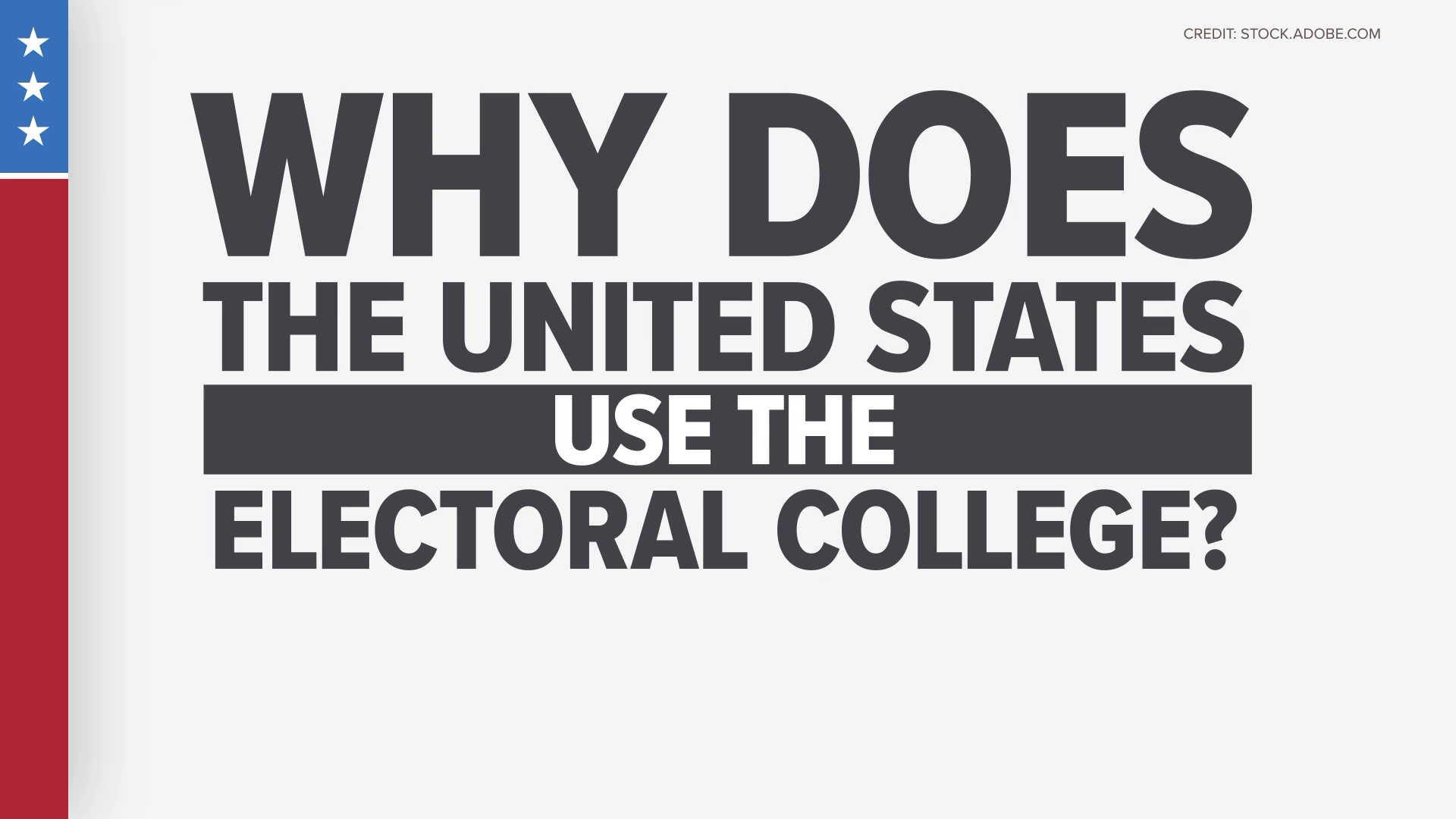With so much attention around Election Day throughout the country, we're also seeing a fair amount of misinformation being posted and shared online.
Our VERIFY researchers are breaking down some of the viral photos and videos people have been sharing online so you know what's real, what's untrue and what's unverified.
We'll be updating this story throughout Election Day and into the evening, so be sure to refresh the page to see the latest updates.
CLAIM: All votes have to be counted by the end of Election Day
As Election Day came and went, there have been repeated claims that states need to stop counting ballots by the end of the day.
But these claims are FALSE. The National Conference of State Legislatures explains that "the close of the polls is not the end of an election. Depending on state law, absentee ballots are still arriving—and still being counted—for days after Election Day."
While news outlets can call "winners" on election night, those are just projections based off the percentage of votes that have been reported and the outstanding number of ballots. States aren't required to finish counting their votes on Election Day and they often take days or weeks to certify the results, including all mail-in and absentee ballots.
Despite what the laws state, President Trump has repeatedly decried a Supreme Court decision that allows Pennsylvania officials to count absentee ballots received as late as Friday as long as they are postmarked by Nov. 3.
There is no federal cutoff for states counting ballots, other than that states must have results ready for the Electoral College vote in December. This year, that’s scheduled for Dec. 14.
CLAIM: Former President George W. Bush endorsed Joe Biden for President
Despite what an image circulating on social media has claimed, former president George W. Bush has not endorsed Joe Biden for president.
A Twitter user tried to spread the misinformation by tweeting it out and tagging a number of prominent celebrities and politicians.
George W. Bush has not publicly endorsed either candidate for the 2020 presidential election. In the 2016 election, Bush spokesperson Freddy Ford said that Bush "does not plan to participate in or comment on the presidential campaign."
As of now, that has not changed in the 2020 election.


CLAIM: Philadelphia poll watcher wrongfully turned away from polling site
Early during Election Day, a video posted on Twitter that appeared to show a GOP poll watcher get turned away from a polling site in Philadelphia went viral.
Kevin Feeley, a media representative for the Philadelphia City Commissioners, told VERIFY the poll watcher had the correct certificate that would allow him to enter, but the election judge didn’t let him inside because the ward division number didn’t match that of the voting site.
Feeley explained that regardless of the number on the certificate, the poll watcher was entitled to enter other voting sites in the jurisdiction. “It was an inadvertent and honest mistake,” he added.
He said the rules were clarified for the election judge, but the poll watcher had moved on to another site after the incident.
CLAIM: President Trump has said he wants voting to stop
Voting has stopped. It's the counting that has continued.
The National Conference of State Legislatures has a chart that lists for how long each state has to certify election results. Local election officials in Wisconsin and Pennsylvania have over a week to complete their counting. Local officials in Michigan have over two weeks.
Trump also tweeted that he wants to "go to the Supreme Court" to ensure voting stops. The Supreme Court has already shut down an attempt to extend the deadline to receive mail ballots in Wisconsin. So ballots coming in past Election Day there won't be counted.
The deadline for ballots to arrive in Pennsylvania was extended by three days, and there's still the possibility that the Supreme Court revisits and denies that extension. Pennsylvania state officials have told local election officials to keep ballots received during that extended deadline period separate from the other ballots. Even ballots received after Tuesday had to have been postmarked by Election Day to count.
An attempt to extend the deadline for mail-in ballots in Michigan was rejected by the State of Michigan Court of Appeals.
Regardless of when the ballots are received, the counting of ballots received on or before Election Day is continuing. The process of finalizing results isn't instant, and never has been.
CLAIM: Some states have more votes than registered voters, others have unusually high turnout
A number of claims have tried to argue that there are more votes than registered voters in some key battleground states while other key battlegrounds have turnout unusually high above average.
We broke down the number of currently casted vote totals with the number of registered voters in eight states subject to these claims and found votes surpassed voters in none of the listed states. You can see the breakdown -- with links to the states' voter registration statistics -- in this spreadsheet.
Several of these states allow for voters to register to vote at the polls on Election Day. Those states, marked with green on the spreadsheet, haven't updated their voter registration numbers following Election Day as of yet, meaning their voter registration totals are already out of date.
Some of those states may disregard total registered voters when calculating turnout because they allow voters to register while voting. In Wisconsin, where people claimed turnout was unusually high, the Wisconsin Elections Commission says it "calculates voter turnout as a percentage of the voting-age population." The turnout this year isn't exceedingly greater than in past years when using their formula.
CLAIM: Arizona election officials say Sharpie not having impact on vote count
Some voters were concerned that the usage of Sharpie pens in Maricopa County, Arizona's most populous county, was invalidating ballots.
However, the Maricopa County Elections Department said the Sharpies were the best to use to fill out their new ballots.
Arizona's Secretary of State Katie Hobbs told a local news station that those ballots were being counted and there are systems in place to count ballots that tabulation machines cannot read for whatever reason.
The Arizona Elections Procedures Manual outlines how boards certify voters' intent so that a vote can be counted if the tabulation machine fails to read the ballot.
CLAIM: About 130,000 votes for Biden were added to Michigan's tally overnight
A pair of screenshots showing 130,000 consecutive votes going for Biden in Michigan early Wednesday morning went viral.
However, the original person who posted the screenshots deleted the tweet because he learned that it was an error caused by a typo.
An extra zero accidentally added to Biden's tally in one county caused results counters to give him nearly 130,000 additional votes. The error was fixed and so about 130,000 votes were taken away from Biden's total.
In fact, the results tracker's timeline shows that it's likely the screenshots actually showed the moment those 130,000 votes were taken away from Biden's tally.
Regardless, elections take weeks to certify so results can be double-checked and triple-checked for human error.
CLAIM: People can vote twice if they vote in-person and by mail
No, an NCSL blog post explains how election officials often have records of who voted the moment they tally you in-person or verify your mailed ballot. If they receive a mail-in ballot first and then you vote in-person, you may have the option to fill out a provisional ballot and they will count whichever ballot they have first. If you vote in-person and then they receive a mail-in ballot, they will reject your mail-in ballot.
There are also other reasons to fill out a provisional ballot, such as your voter registration information being in question or problems caused by a lack of a required ID. More information about provisional ballots can be found in our article below.
CLAIM: Anyone can go into the vote counting centers to watch the ballots being tallied
It depends on your state, but in many cases that’s not true. To watch in person, you generally have to be named by your party to do so, according to the report “Who Can Observe U.S. Elections” by the Carter Center and a summary by the National Conference of State Legislatures. Some states require any others who want to observe the tabulations to get the permission of the secretary of state.
If you really want to see the vote counts, some jurisdictions do livestreams of the room where it happens. The MIT Technology Review lists some of the cities, including closely watched Philadelphia. Arizona, where protesters have demanded vote counting to stop, requires that vote counts be livestreamed and the video stored through the challenge period in general elections.
CLAIM: Dead person in Michigan voted
One of the most viral claims of voter fraud through deceased voting says that a William Bradley from Detroit who died in 1984 voted in this election
To the original poster’s credit, you do find a returned absentee ballot under a William Bradley born in March 1902 from the 48207 zip code when you look it up on Michigan’s online voter index. However, you can also find a William Bradley born in July 1959 from the 48207 zip code who does not have a returned absentee ballot and is in the same precinct in Michigan’s online voter index.
Politifact reached out to that William Bradley and found out it was the deceased Bradley’s son. He said he received two absentee ballots, one for himself and one for his deceased father. He threw out his father’s and mailed his own ballot in. He said an error incorrectly attributed the vote to the elder Bradley rather than him.
The Michigan Department of State website addresses claims of deceased voters voting in elections. They say, “ballots of voters who have died are rejected in Michigan, even if the voter cast an absentee ballot and then died before Election Day.”
They also state something that appears to explain the Bradley situation: “On rare occasions, a ballot received for a living voter may be recorded in a way that makes it appear as if the voter is dead. This can be because of voters with similar names, where the ballot is accidentally recorded as voted by John Smith Sr when it was actually voted by John Smith Jr; or because of inaccurately recorded birth dates in the qualified voter file; for example, someone born in 1990 accidentally recorded as born in 1890. In such scenarios, no one ineligible has actually voted, and there is no impact on the outcome of the election. Local clerks can correct the issue when it is brought to their attention.”
Something you’d like VERIFIED? Click here to submit your story.

